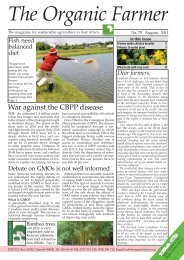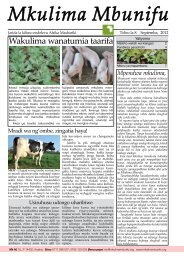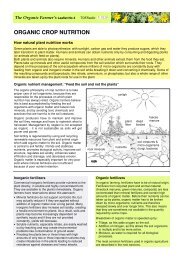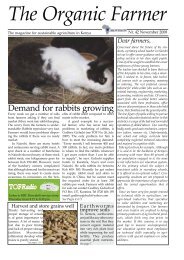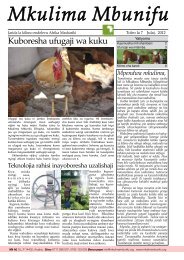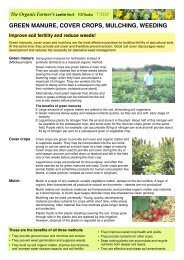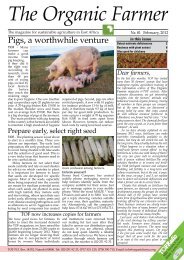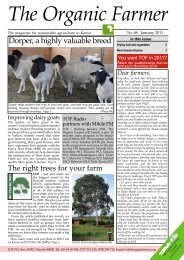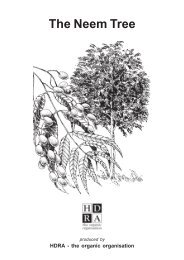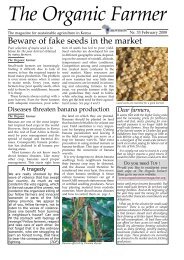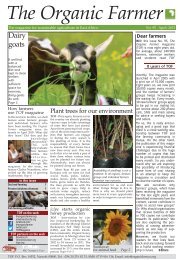Termite Control without Chemicals - Infonet-Biovision
Termite Control without Chemicals - Infonet-Biovision
Termite Control without Chemicals - Infonet-Biovision
- No tags were found...
Create successful ePaper yourself
Turn your PDF publications into a flip-book with our unique Google optimized e-Paper software.
<strong>Termite</strong> <strong>Control</strong><strong>without</strong> <strong>Chemicals</strong>produced byHDRA - the organic organisation
<strong>Termite</strong> <strong>Control</strong><strong>Termite</strong>s: what are they?<strong>Termite</strong>s are a group of insects (Isoptera) consisting of 2,500 species of which300 are considered pests. <strong>Termite</strong>s are one of the most damaging pests in thetropics and can cause considerable problems in agriculture, forestry and housing.There are several families and sub-families. Some have nests underground,others in wood, for example hollow trees, and some build mounds.Before control methods can be adopted a basic identification of the pest speciesor family is needed. This can be done by observing pest behaviour and thedamage pattern on the tree or crop.The most troublesome type of termites in agriculture are the fungus-growingtermites. They feed on dead organic material such as crop residues, mulchesand soil organic matter (humus). However when this type of food is not availablethey will eat live plant material including crops such as groundnuts, milletsand maize.Harvester termites are found in dry and semi-desert areas. They buildunderground nests which can be difficult to locate. They collect live green plantmaterial and cause damage to living grasses, crops and seedlings. They willattack weak plants that are wilting or damaged.page 1HDRA - the organic organisation
<strong>Termite</strong> <strong>Control</strong>Benefits provided by termites?Although usually considered pests, termites can also provide many benefits.Therefore before control measures are used an assessment should be madeof the following benefits against the loss of termites from the ecosystem.Benefits include:• Aeration of the soil due to termite burrowing activities.• The breakdown and release of organic matter as termites eat anddigest soil.• Improved soil fertility when termite mounds, which are rich in minerals,are crushed down and incorporated into the soil.• A source of minerals for cattle who lick the mounds.• A source of protein rich food for many organisms including ants,guinea fowl and other mammals including humans.HDRA - the organic organisation page 2
<strong>Termite</strong> <strong>Control</strong>Chemical controlThe generally accepted method of termite control over the years has beenchemical pesticides. However chemicals are expensive and have manyharmful effects.Safety for peopleArtificial pesticides can quickly find their way into food chains and water courses.This creates health hazards for humans. There is also much concern for peopleusing chemical pesticides. The products may be misused because the instructionsare not written in the language understood by the person using them. This hasled to many accidents and deaths.Safety for the environmentThere are a number of harmful effects that chemical pesticides can have on theenvironment.• Artificial pesticide can kill useful insects which eat pests. Just one spraycan upset the balance between pests and the useful predators which eatthem.• Artificial chemicals can stay in the environment and in the bodies ofanimals causing problems for many years.• Pests become resistant to pesticides so more powerful chemicals areneeded.CostUsing natural pest and disease control is often cheaper than applying chemicalpesticides because products and materials which are already in the home andaround the farm are most often used.page 3HDRA - the organic organisation
<strong>Termite</strong> <strong>Control</strong>Organic control methodsThere are a number of alternatives to using chemical pesticides for termitecontrol. These methods work within the natural system and help promote naturalpest control mechanisms.• Organic control methods do not pollute the environment and are not harmfulto beneficial insects and animals, or to the people using them.• Organic methods aim to use locally available materials and do not rely onimporting expensive materials from elsewhere.• Organic methods are cheap and easy to use.• Organic methods preserve genetic diversity within the farming systemwhich helps provide resistance to termite pests.• Organic methods regulate termite numbers rather than eliminate them sothat the benefits provided by termites are not lost.The level of control depends on the knowledge of pest species, the tree or cropspecies, climatic conditions and other environmental factors such as soil typeand local vegetation cover. Methods of control are more effective if used inconjunction with each other, with maximum use of local knowledge and resources.<strong>Termite</strong> control methods are described in this booklet. Some of them come fromindividual research studies and have not been widely tested.HDRA - the organic organisation page 4
<strong>Termite</strong> <strong>Control</strong>Adding organic material to the soilFungus-growing termites prefer to eat dead plant material. Their attacks arethought to be related to soils with low organic matter content. This is becausesuch soils do not contain enough food for termites to live and they resort tofeeding on living plant material. Adding compost or well-rotted manure to the soiland sowing green manures helps to increase the organic matter in the soil.Digging compost into the soil to increase organic matter contentEncouraging predators<strong>Termite</strong>s have many predators because they provide a source of protein. Insectsthat eat termites include spiders, beetles, flies, wasps and especially ants. Otherpredators including frogs, reptiles, birds and mammals such as aardvarks,pangolins, bats, monkeys and humans. Encouraging this kind of wildlife willhelp to reduce the number of termites. Bushes and trees are a home for manyof these useful creatures. These areas of natural habitat can be left aroundfields where crops are grown. If these areas are destroyed then there is animbalance between the populations of predator and pest.page 5HDRA - the organic organisation
<strong>Termite</strong> <strong>Control</strong>Substitute food sourcesDamage from termites which feed on dead plant material can be reduced byadding organic material to the soil. The farmer should avoid having bare, drysoil around crops.However, there is also a short term solution which involves providing termiteswith an alternative source of food. This can be done by using mulch around thebase of plants. Mulching with items such as hay, manure, wood shavings, woodash or threshed maize cobs has been shown (in South Africa and Uganda), todramatically decrease termite attacks. <strong>Termite</strong>s are attracted to the mulch ratherthan the crop. Vetiver grass leaf mulch has been shown to prevent termiteattack around the base of trees.However, offering substitute food may also attract termites to the area andincrease the overall damage done to trees and crops. Each case is likely to bedifferent and dependent on termite species and tree/crop species.Crop rotationPlanting the same crop on the same land year after year reduces soil fertilityand structure. Crops growing in such conditions will be weaker and susceptibleto termites. Crop rotation can play an important role in reducing termite attack.Crop rotation means that crops are grown on a different piece of land eachyear. This can prevent pest and disease build up and also help the soil torecover nutrients.HDRA - the organic organisation page 6
<strong>Termite</strong> <strong>Control</strong>Healthy plants for transplanting• Plants which are suffering from disease or lack of water are generally moresusceptible to termites than healthy plants. It is therefore important thatplants are kept healthy and watered.• In dry areas it is recommended that seeds should be sown at the beginningof the wet season to give the plants a chance to establish themselves andremain healthy in the field.• Only healthy plants should be transplanted into the field. Great care shouldbe taken during transplanting and pruning (leaves and roots) as termitesmay enter plants through scar tissues.• If there is a bag around the root of a tree seedling, it is recommended thatit should not be completely removed when transplanting as it can act as abarrier against termites. However it is important that the bag does notprevent the plant/roots from growing. It should still allow the plants roots togrow into the soil. Banana fibre pots are very ineffective as termites willeat them.• Adding organic composts and manure to the planting area is recommendedas this will produce healthier trees and crops. Whereas, inorganicfertilisers encourage fast growing soft tissue which is more likely to beattacked by termites.MagnetsPlacing strongbar magnets in the soil next to a new termite mound can prevent amound from growing. This disturbs those species of termite which build theirmounds in a north-south direction along magnetic lines.page 7HDRA - the organic organisation
<strong>Termite</strong> <strong>Control</strong>Breaking up mounds and queen removalOn deep cracking soils, the regular disturbance through cracking preventstermites from building extensive mounds. On other soils artificial breaking up ofmounds and galleries can have the same effect. Repeated digging and ploughingof the soil may reduce termite damage. Manual and explosive destruction ofnests followed by the removal of the queen is also effective.Physical barriersBuilding barriers around buildings and nurseries can prevent attack fromsubterranean species. Barriers should be partially above and below ground andshould be composed of a material that is impenetrable to termites such asbasalt, sand or crushed volcanic cinders. Particle size of the material is critical,they should not be too large for the termites to carry away, and not so small thattermites can pack the particles to create a continuous passage through whichthey can move.HDRA - the organic organisation page 8
<strong>Termite</strong> <strong>Control</strong>Plants with termite resistanceCropsThere is little knowledge about crop resistance to termite attack. However, ingeneral indigenous crops are more resistant to termites than exotic crops. Forinstance, in Africa, sorghum and millet are more resistant to termites than maizeand cowpea, and bambara nuts are not attacked while groundnuts suffer seriousdamage. Annual crops are attacked towards harvest time while perennial cropsare attacked most destructively during dry seasons or in early stages of growth.It may be advisable to establish small plantations in the field prior to larger scaleplantations in order to discover if the crop or tree is resistant to local termites inlocal conditions.TreesThe degree of resistance depends on the tree species, the origin of the treeseed, the age and condition of the tree, the termite species and where the treeis growing (region/country). However as with crops, indigenous species aremore resistant than exotics. The following table gives a number of trees andshrubs that have shown to be termite resistant.page 9HDRA - the organic organisation
<strong>Termite</strong> <strong>Control</strong>Trees and shrubs with termite resistanceSpeciesCommon name<strong>Termite</strong> resistant partCommentsAcacia polyacanthahook thornMore resistant that mostAcacias due to high numberof resinsAfrormosia laxifloraWood/pulpAlbizia odoratissimates shade treeWood/pulpAlbizia zygia<strong>Termite</strong> durable butnot resistantAzadirachta indicaneem, nimBorassus aethiopumAfrican fan palmThe fibrous wood is highlyresistantBrachylaena hutchinsiimuhugu oil treeHighly resistant, almostimpenetrable to termitesCapparis aphyllaWood/pulp<strong>Termite</strong> resistant shrubCatalpa bignonioidescommon catawpaResistant to ReticulitermesflavipesCedrus deodorahimalayan cedarWood/pulpDaniellia oliveriGum/resinDetarium senegalenseWood/pulpOral poisonDodonaea viscosapurple hop bushWood/pulp<strong>Termite</strong> resistant shrubErythropleum suaveolensWood/pulpOral poisonEucalyptus microcorysMore resistant than otherEucalyptusGrevillea robustasilky oak, silver oak<strong>Termite</strong> tolerant in TanzaniaJuniperus proceraE. African pencil cedarHighly resistantMelia azedarachwhite cedarWood/pulp, leaves,Oral poisonseeds, oilStrychnos nux-vomicaLeavesOral poisonZanthoxylumWood/pulpxanthoxyloidesThere are many other species with termicidal properties including: Acacia catechu(catechu, khair), Acacia mearnsii (black wattle), Acacia melanoxylon (Australianblackwood), Albizia saman (saman), Afzelia cuanzensis (pod mahogany), Balanitesaegyptiaca (desert date), Bridelia micrantha (mitserie), Cassia brewsteeri (Brewsterscassia), Casuarina cunninghammiana (river she-oak), Eucalyptus camaldulensis (redgum), Gliricidia sepium (mother of cocoa), Grevillea glauca (East African mahogany),Leucaena leucocephala (ipil ipil).HDRA - the organic organisation page 10
<strong>Termite</strong> <strong>Control</strong>Plant preparationsPlant parts and plant extracts can be used effectively. These can be removedfrom the plant and used as a natural insecticide by grinding up the relevantparts, placing in boiling water, stirring and leaving to soak. The mixture is thensprayed onto the pest infested crop. Alternatively the plant part, such as toxicfruit juices, pulps or shavings can be applied directly.Grinding up plant parts to make a natural preparation for termite controlpage 11HDRA - the organic organisation
<strong>Termite</strong> <strong>Control</strong>Plants with termite control propertiesSpeciesCommon name<strong>Termite</strong> control propertyParts usedAcacia niloticaEgyptian thornAnti-insectWood/pulpAgave americanaAmerican aloeRepellent, insecticidalWhole plantAllium sativumgarlicAnti-feedant, bacterial,fungicidal, repellentBulbsAnacardium occidentalecashewAnti-insect, repellentSeeds, oilArgemone mexicanaMexican poppyInsecticidal, repellentWhole plantAzadirachta indicaneem, nimTermiticidal, anti-feedantLeaves, seedsBidens pilosablackjackAnti-feedant, insecticidal,repellentWhole plant, matureseedsBoswellia dalzielliRepellentGum/resinCalatropis giganteaAnti-insectLeaves, sap/latex/juiceCalatropis proceraTermiticidalLatexCarya ovataCamellia sinensisshagbark hickoryteaTermiticidalAnti-feedant, insectidicalBarkLeaves and fruitCarica papayapawpawInsecticidalFruit, fresh leavesand rootsCassia siameayellow cassia,RepellentUsed as a leaf mulchCedrela odoratakassof treeWest Indian cedarTermiticidalWoodChemopodiumwormseedAnti-feedant, insecticidal,Whole plantambrosioidesrepellantCleistanthus collinusRepellentBarkCommiphora africanaTermiticidalGum/resinConsolida regalisDiospyros ebenumblue cloudebonyTermiticidalAnti-insectSeedsRootsHardwickia manniiTermiticidalStem/branchesHyptis spicigeralabiataeRepellentAerial partsJuniperus virginianaLeucaena leucocephalaMelia azedaracheastern red cedaripil ipilchinaberry, persian lilacAnti-insectRepellentAnti-feedant, contactpoison, repellantUsed as a leaf mulchBark, branches, leaves,fruit, oilMesna ferreaOcimum basilicumOcimum canumOcimum urticifoliumPinus strobusProsopis africanaQuassia indicaQuercus prinusSamadera indicasweet basilwild basilbasilchestnut oakAnti-insectInsecticidal, repellentInsecticidal, repellentTermiticidalAnti-insectTermiticidalTermiticidalTermiticidalWhole plantWhole plantWater-based extractsBarkRootsLeavesBarkLeavesSantalum albumSassafras albidiumSemecarpus anacardiumSwartzia madagascariensisTagetes minutaTectona grandissandalwoodMexican marigoldteakAnti-insectTermiticidalAnti-insectRepellentRepellentBarkSeedsFruitWater-based extractsWood/pulpHDRA - the organic organisation page 12
<strong>Termite</strong> <strong>Control</strong>Reference list‘Organic <strong>Termite</strong> <strong>Control</strong>’ (1994) P Forshaw. HDRA undergraduate report.‘Natural Pest and Disease <strong>Control</strong>’ (undated) H Elwell and A Mass, publishedby the Natural Farming Network, PO Box 8515, Causeway, Harare, Zimbabwe.‘Natural Pest and Disease <strong>Control</strong>’ (1996) Gaby Stoll, published by MagrafVerlag, PO Box 105 97985 Weikersheim, Germanypage 13HDRA - the organic organisation
<strong>Termite</strong> <strong>Control</strong>NotesHDRA - the organic organisation page 14
Further information on termite control and on organic farming can be obtainedfrom HDRA. Other publications include booklets covering composting, greenmanures, weed control and the neem tree, as well as single information sheetsabout crop pests and diseases and their control, natural pesticides and greenmanures. Please write to:HDRA - the organic organisationRyton Organic GardensCOVENTRY CV8 3LGUnited KingdomTel: +44 (0) 24 7630 3517 Fax: +44 (0) 24 7663 9229Email: ove-enquiry@hdra.org.ukWebsite: www.hdra.org.ukThe aims of HDRA - the organic organisation are to carry out scientific researchinto, collate and disseminate information about, and promote interest in organicgardening, farming and food in the UK and overseas. For more than a decade,HDRA’s international programme has been involved in the support and extensionof sustainable farming practices; supporting research on aspects of tropicalorganic agriculture, providing advice and literature on appropriate organictechniques and providing tree seeds and technical information to organisationsinvolved in tree planting and research.We gratefully acknowledge the generous support of the Charlton CommunityDevelopment Trust in the production of this booklet.This material may be reproduced freely for non-profit making purposes.©2001 HDRA Publishing



